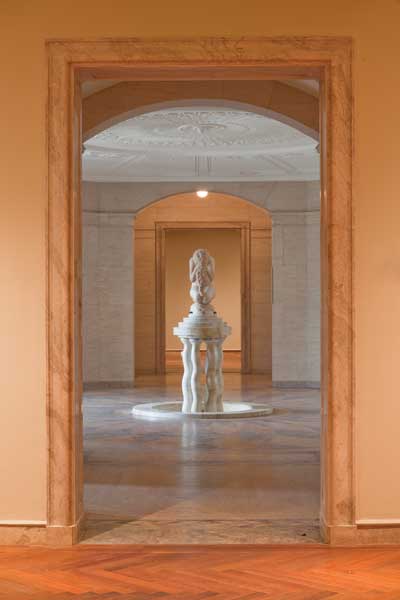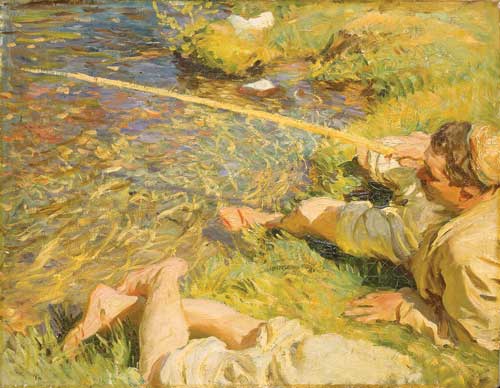Magical Date with Destiny
Imagine this moment: Waters bubble, a crosswind stirs the air, beams of light flash, the scalloping of a half shell swirls into sight, and a divinely beautiful maiden rises, fully formed, from the sea foam of ancient waters. The Greeks called her Aphrodite, the Romans called her Venus, but both envisioned her birth to be as fantastical as it was formative for Western art. The shapely glory of this goddess of love and beauty has been celebrated by artists from antiquity (Apelles) to postmodernism (Luciano Fabro). Venus is a powerful symbol of what it means to arrive thoroughly actualized.

How fitting then, that the centerpiece for the September 7th re-opening of the Addison Gallery of American Art at Phillips Academy in Andover, Massachusetts, is Paul Manship’s graceful art deco fountain sculpture Venus Anadyomene, which has been on display in the gallery’s rotunda since the building’s original opening in 1931. For the last two years, the museum has been undergoing an expansion and renovation including the addition of a learning center, as well as storage, office and preservation space, and upgrades to the original building’s infrastructure. The renovation also sports the area’s first self-sustaining green roof. As these larger changes have been taking place, Manship’s statue has also been on a quiet journey that might be seen as yet another birth of Venus.
Before the statue took its place of prominence at the Addison, however, a number of other events had to take place over the years—almost as if the statue, which Manship was busily making in his studio in New York City, had a magical date with destiny.
In 1928, Thomas Cochran, a prominent banker and Phillips graduate, donated dozens of paintings to celebrate his alma mater’s 150th anniversary and to launch the creation of a gallery of art, which he would fund and endow to “enrich permanently the lives of the students.” A year later, Charles A. Platt, architect for the Freer Gallery of Art in Washington, D.C., broke ground for the Addison Gallery of American Art, whose mission was to “collect works of art or craftsmanship produced by native-born or naturalized citizens of the United States.” (Exceptions would be made for photographs and books by other than native-born or naturalized citizens; portraits or busts of Americans and portrayals of American scenes or vessels by artists of foreign birth produced not later than 1800; pieces of pottery or glassware of whatever origin or date decorated with American scenes; and scale models of famous ships connected with the history of the U.S.)
Two years later, the Addison, named after the mother of Cochran’s close friend, opened with 400 works, including ones by Winslow Homer, George Bellows, James McNeill Whistler, Maurice Prendergast, and Thomas Eakins. At the center of the elegant rotunda was Manship’s Venus Anadyomene, which Platt had seen in the scu
lptor’s studio and recognized in the piece a simpatico echo of his own approach to light, form, and spirit. The statue and the rotunda were a sublime match.
Manship went on to create his most famous work and arguably one of the most recognizable American icons ”the Prometheus statue at Rockefeller Center. And the Addison was making its own strides. Within two decades, the gallery’s collection includ
ed a number of outstanding American works, often from famous philanthropists and artists, such as Peggy Guggenheim and Georgia O’Keeffe.
Today the gallery’s collection numbers close to 17,000 works in varied media by some of the country’s most respected artists including John Singer Sargent, Alexander Calder, Arthur Dove, and Marsden Hartley. The gallery’s 7,000 photographs make up a significant portion of the collection, which serves not only the students at Phillips Academy but the environs of Boston and greater New England. The “secret weapon” of the Addison, says associate director Susan Faxon, is that “everything looks wonderful here.” With the new changes to the gallery, the art will be displayed, preserved, studied, and experienced with a renewed ease and effectiveness.
“The museum is a small building but the vistas give us that gift of spaciousness, and the galleries give us an almost domestic sense of proportions and intimacy,” says Brian Allen, director of the Addison. “I’ve heard this over and over and over again. You really feel a sense of tranquility that makes you feel at home.”
No one would contest that the Addison is among the country’s smallest and yet impressive collections.
And few would argue that Manship’s artistry with Venus is both a stellar example of his work and a signature piece of late art deco era. Where the statue fell short—as noted by early newspaper reviews of the gallery—is its functionality. Water never properly flowed up the columned legs of the piece to the lion-head spouts on the base of the figure and over the wedding cake tiers. For more than seventy years, the statue was a static representation of its subject’s fluidity.

A thirty-million-dollar campaign (which included both renovation and endowment support) turned renovation of the Manship statue into a high priority, says Faxon. Phil Peterson of Peterson Engineering, PC, redesigned an efficient pump system (modeled on an inexpensive birth bath), and objects conservator Adam Nesbit at Williamstown Art Conservation Center performed the cleaning and conservation of damaged parts. Plumbers and art handlers were also part of the crew that performed the delicate refurbishing of the statue, which was the first work of art reinstalled in the building when major construction was completed this spring. Gallery workers gathered for the return, and even a few tears of welcoming joy were shed.
In the stillness of the empty gallery last spring, Manship’s Venus crouched in silence, frozen in the moment of wringing sea water from hair. The open space between the arch of her back and the symmetrical cascade of her tresses framed a view down a long hall to a sunlit gallery. Behind the statue was a second gallery, in front of it a third, and the circular motion of the rotunda created an almost oceanic sense of balance and movement. Platt was right through the ages: If ever a statue belonged in a space, this was it.
“She washes her hair, which is rippled, and as the hair ripples, the water is flowing and making more ripples, which are echoed by the legs of the sculpture,” explains Faxon. “The composition is beautiful. It’s the quietest statement of movement within this serene octagonal space. Through Venus, you see everything beyond her in the museums other rooms. The whole building flows so the statue is a perfect statement.”
Faxon appropriately used the word “mythic” to describe the statue. But “epic” might be the better word for the building itself. Clearly, Platt was reaching beyond the modest limits of space to a most powerful expression of synchronicity.

“You can see the statue before you get into the building and that creates a frisson of excitement,” says Allen. “Then when you come into the rotunda and finish admiring the statue, you can go straight, left, right. There is very little directed space at the Addison, and I think Platt was conscious of this. He wanted to encourage high-school students to indulge in the one gift youngsters certainly have: limitless possibility. You can go in any direction. In keeping with Phillips Academy: The world is open to you.”
When the art and the public return to the gallery, water will again flow—this time properly—from an elaborate pumping system in the room below the goddess’s perch. And Venus will be back in the act of washing her hair and inspiring the world to think more deeply about beauty, space, and art.
Alicia Anstead is a freelance journalist in Boston, Massachusetts. She can be reached through www.aliciaanstead.com.
